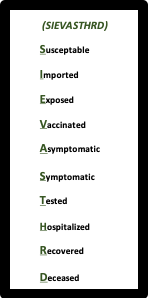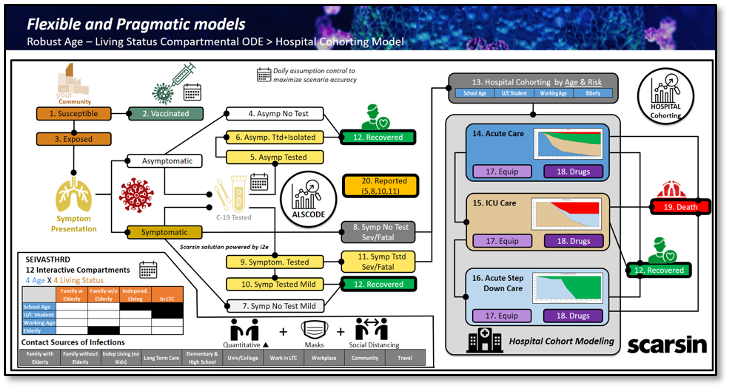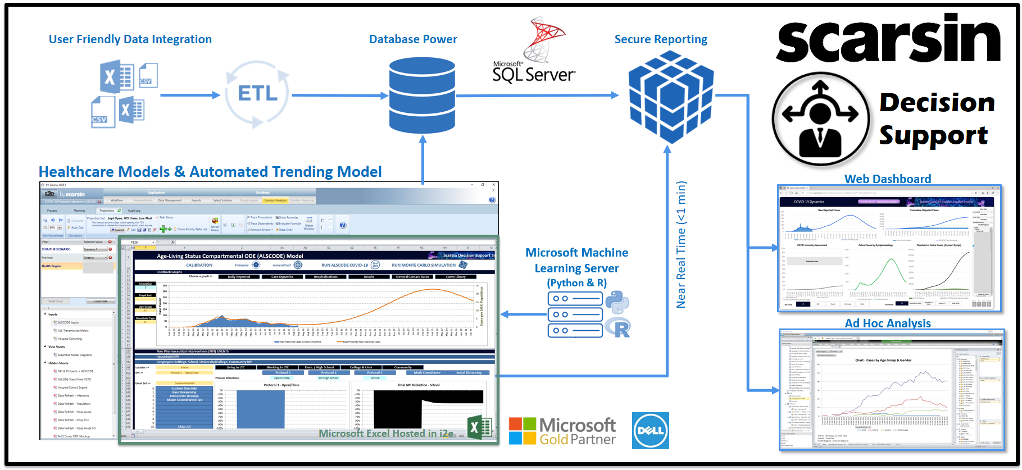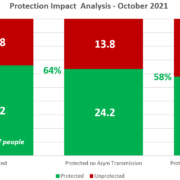A National Crisis Deserves a National Pandemic Decision System
As a company that specializes in forecasting and decision support for diseases, we recognized in March the potential crisis that was coming. Lives lost, economic turmoil, mental health impact, bankruptcies, lives ruined… We knew we could help!
The decision making framework around COVID-19 impact is identical across the country. The forecast assumptions, such as the demographic structure of the population or behavioral patterns within communities might differ by health regions, but COVID-19 decision making framework is aligned, and despite a multi-tiered healthcare delivery approach it was obvious – Canada needed a national pandemic forecasting & decision system!!!
There is more risk ahead of Canada today than what is behind us.
The overwhelming evidence and mathematical models describing the dynamics of COVID-19 support the certainty of a second wave of the epidemic. Questions like: “When?”, “How high?”, “Will it overwhelm the contact tracing and hospital treatment capacity?”, “How many more people will die?”, “Will it force a partial or broad shut down?”, are just some of the questions still facing Canadian decision makers.
“A good hockey player plays where the puck is; a great hockey player plays where the puck is going to be.”
— Wayne Gretzky
Great decision makers need to understand where COVID-19 risk is going to be and to proactively implement strategies to minimize risk. Forecasting is what informs decision makers. It is the difference between reactive and proactive. COVID-19 exploits every weakness in every system 24/7 without rest, and this is being demonstrated on a daily basis.
Here are the key elements of a National forecasting system:
- Create a central data repository for all de-identified covid-19 case data
- Deploy a centrally integrated ensemble approach (multiple styles of models) to triangulate forecasting
insights
o Extremely cost effective
o Central quality assurance and validation checks- Maximize the design of the models to align to real-world decision making around
- School reopening,
- Business reopening
- Community behavior
- Enforcing compliance with masks and social distancing,
- Vaccine deployment
- Travel restrictions…
- Leverage, where appropriate, any third party data to better inform assumptions and insights
o Google, Apple, Facebook mobility data
o Environics data about the Health Regions to identify potential predictive covariates - Deploy the solution in a bottom-up user friendly manner
- Maximize accuracy through more informed local assumptions combined with provincial policy
decisions - Drive analysis to the front lines to inform them of Covid-19 dynamics so they can plan fast consolidations to gain diagnostic (past/current) and predictive (future) insights at the health region, province and federal level
- Maximize accuracy through more informed local assumptions combined with provincial policy
- Enable the solution in an enterprise class forecasting platform with a proven track record on a global basis
The case for a national approach
A National Forecasting system would help Canadian healthcare decision makers make informed and evidence-based decisions with a longer planning horizon.
We moved through a systematic data validation and consolidation process. Quality and consistency of several public data providers have been examined rigorously and eventually the most reliable ones were integrated to our system. We focused on reverse engineering the needs of public health decision makers to ensure the model was pragmatic to real world decisions. This is what transforms it from simply a forecast model to one that supports decision analysis.
We also took time to benchmark the capabilities against prominent models including: the IHME model 1, the PHAC model 2 , Australia’s Doherty Institute model 3 , the Los Alamos National Lab model 4 , Alison Hill’s model 5 , the University of Toronto model 6 . We are confident that we have developed a model capable of supporting robust decision support for Canada.
A typical ensemble approach to pandemic forecasting involves three forecasting approaches:
- Automated time series forecasting of critical COVID-19 metrics (reported cases, hospitalizations, deaths…)
using either statistical or machine learning approaches - A compartmental ODE model often referred to as a SEIR (susceptible, exposed, infected, recovered)
- An agent-based model with computational schemes that emulate individuals making decisions depending
on a set of programmable rules
Why this approach works

Let’s focus on the second approach, a compartmental ODE SEIR, to illustrate the value that private expertise can bring to the COVID-19 fight. The Scarsin solution is an Age/Living Status Compartmental ODE (ordinary differential equations). The unique design of our solution is the expanded functionality to match the input parameters to real world dynamics. The figure below outlines the current design, which is being enhanced further with a deep dive focus on daycare, elementary and high school reopening. In essence we extended and enhanced a SEIR approach into a SEIVASTHRD approach.
We also integrated a hospital cohort model (see below) downstream to produce more accurate forecasts of patient demand to acute and ICU beds.


This figure outlines the Scarsin platform which leverages the Microsoft BI stack. It has end to end support including data integration, forecasting modelling, automated time series forecasting using Microsoft Machine Learning Server, web dashboard and ad hoc analysis. It also leverages Microsoft Office to create user friendly model designs. This platform has been used by Global 500 clients for mission critical forecasting processes for more than 10 years.
Enabling national decision making
The most important determinant of system benefits is how it can enable decision making. The Scarsin solution is designed to answer common questions with an alignment to real world dynamics.
- Travel – Dynamic changes in Travel importation from the US, International and domestic travel based on daily changes
- School Reopening – Wide ranging analysis capabilities around the direct and indirect impacts of school reopening strategies (our new review – “Understanding School Reopening Risk – A Decision System Approach” is a strong example of a priority use case)
- Impact of COVID-19 Compliance Fatigue – In terms of both masks and social distancing
- Stage III – Impact of opening the economy
- Vaccines – Evaluating vaccine strategies including approval, supply, injection capacity, patient distribution % and compliance to understand how this game changing dynamic will unfold
All of this functionality and more is available for all heath regions and provinces of Canada loaded with public data. More detailed data can also be loaded as a client.
In order to make this call to action more relevant we will provide a comparison of the Scarsin SEVAISTHRD & Hospital Cohort model with the SEIR model produced by Public Health Agency of Canada (PHAC) in response to Covid-19. [i][ii][iii]

Conclusion
COVID-19 is an incredibly difficult challenge which requires a National Pandemic forecasting solution designed for real world decision making and scaled to the national level. There is a significant opportunity for Governments, Public Health, Hospital and Education decision makers to form partnerships with private firms with recognized global expertise. It is good to remind ourselves that global leaders can and do exist in Canada.
Scarsin answered Canada’s and Ontario’s call for innovation.
We are ready with a National solution and want to HELP!!!
[i] https://nccid.ca/news/phac-modelling/
[ii] https://nccid.ca/wp-content/uploads/sites/2/2020/06/PHAC-User-Guide_JUNE24.pdf
[iii] https://www.canada.ca/content/dam/phac-aspc/documents/services/reports-publications/canada-communicable-disease-report-ccdr/monthly-issue/2020-46/issue-6-june-4-2020/ccdrv46i06a08-eng.pdf
![scarsin logo black] Scarsin COVID 19](https://scarsin-covid.com/wp-content/uploads/2020/03/scarsin-logo-black.png)

Trackbacks & Pingbacks
[…] figure below outlines the scenario based modeling solutions in the Scarsin platform. See “A National Crisis Deserves A National Decision Support System” in the blog section of https://www.scarsin-covid.com for more […]
Comments are closed.